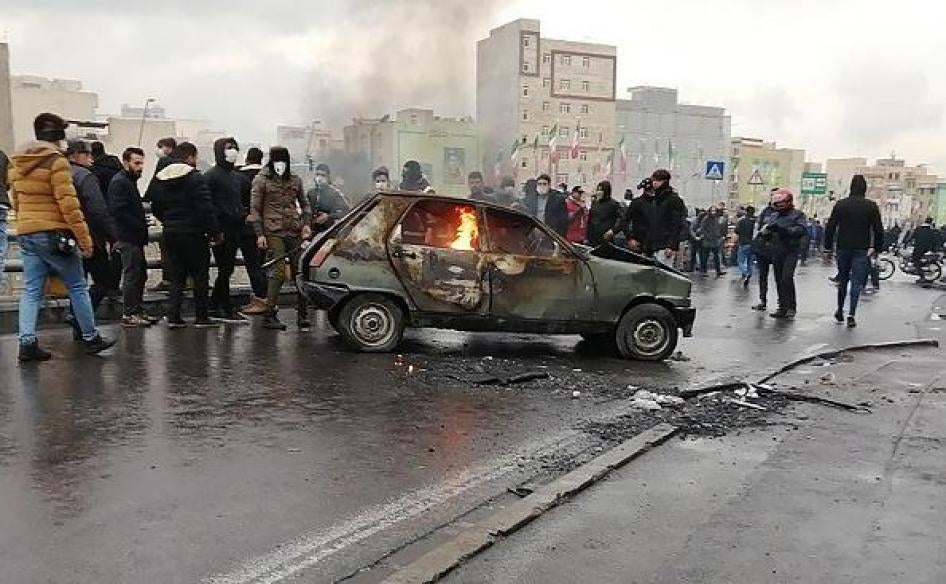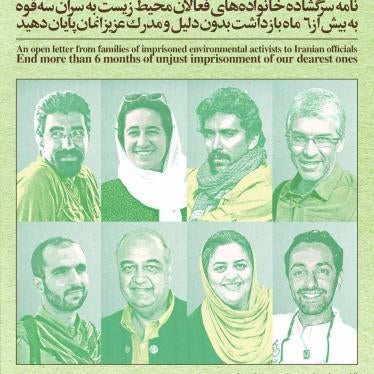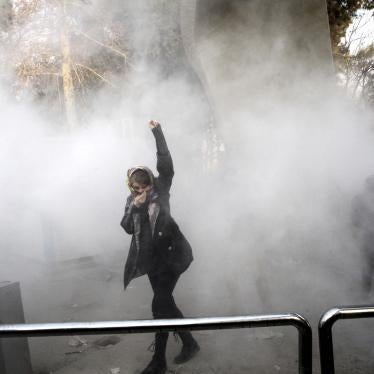(Beirut) – Iranian authorities have failed to provide any real measure of accountability for the violent crackdown against widespread protests that began a year ago, Human Rights Watch said today.
The protests, which began over an abrupt fuel price increase on November 15, 2019 and lasted for a week, transformed into a broader expression of popular discontent with the government’s repression and perceived corruption. The government imposed a near-total internet shutdown from November 15 to 19 and embarked on the most brutal crackdown against protesters in decades.
“One year after the November crackdown, Iranian authorities have avoided any measure of accountability and continue to harass the families of those killed during the protest,” said Tara Sepehri Far, Iran researcher at Human Rights Watch. “Families of hundreds of victims, most of them from the more vulnerable segments of Iranian society, deserve to see those responsible for the serious rights violations held accountable.”
Due to the internet shutdown and authorities’ threats against victims’ families, documenting the full extent of the crackdown, including the total number of people killed, has been difficult. Through interviews with victims and witnesses, a review of photos and videos from the protests, and satellite imagery analysis, Human Rights Watch concluded that security forces used unlawful lethal force on at least three occasions across the country. The total number of such cases is most likely higher.
People interviewed and videos on social media indicated that in several instances, security forces shot people who were fleeing the scene of protests. Also, family members and people with close knowledge of cases of people killed said that victims died from gunshots to the head and/or chest.
According to Amnesty International, at least 304 people were killed. On June 1, Mojtaba Zonoor, the head of Iran’s parliamentary national security committee, put the number at 230. He claimed that the cause of death for 26 percent of cases was still unknown. The authorities have not published any detailed investigation or held anyone accountable for the alleged abuses.
The authorities continue to sentence dozens of people who were arrested during the protests to imprisonment and flogging. On June 24, Iran’s Supreme Court had upheld the death sentences against three young men arrested after participating in the protests, Amirhossein Moradi, Saeed Tamjidi, and Mohammad Rajabi, on charges of “taking part in destruction and burning, aimed at countering the Islamic Republic of Iran.” After a domestic backlash, lawyers representing the men announced that the judiciary accepted their appeal to halt the case.
On August 23, the court of media and culture sentenced six “reformist” political activists to one year in prison for signing a letter condemning the authorities’ crackdown against the protesters.
On several occasions, the authorities attempted to justify the security forces’ unlawful use of force by calling the protesters “rioters.” On December 17, Mahmoud Sadeghi, a former parliament member from Tehran, told the Etemad newspaper that during a parliamentary briefing, a parliament member from Karaj said that two people from his district were shot in the head.
He said he asked Interior Minister Rahmani Fazli why security forces did not target “the lower part of the body.” He said that Fazli did not deny that security forces shot protesters in the head, but instead responded that security forces “also targeted people in their feet as well.”
On December 4, Ayatollah Ali Khamenei, Iran’s supreme leader, endorsed recommendations by the secretary of the National Security Council to consider ordinary citizens who died during the protests but did not participate in them “martyrs,” and to provide government support to their families. Khamenei’s response, however, did not include any provision for investigating allegations of excessive and unlawful use of force by security officers.
Several families whose loved ones were killed during the protests told Radio Farda that judicial authorities referred their case for financial compensation but did not open investigation to identify those responsible for the killings. They also said that the authorities threatened them to remain silent, and/or to accept compensation and forgo demands for accountability. Since July 18, the authorities have detained Manoucher Bakhtiari, the father of Pouya Bakhtiari, a 27-year-old protester who was fatally shot in the head in Karaj.
Human Rights Watch reiterates its call to the UN Human Rights Council to establish a UN-led inquiry into the serious human rights violations by the Iranian authorities during and after the protests.
“Iranian authorities are systematically repressing efforts of those seeking justice for the bloody November crackdown,” Sepehri Far said. “Principled international actors should press Iranian authorities and take actions to make sure Iran can’t get away with such brutal repression.”
|
News Release
Iran: No Justice for Bloody 2019 Crackdown
No Accountability, Threats against Families
Your tax deductible gift can help stop human rights violations and save lives around the world.
Region / Country
Tags
Topic
Most Viewed
-
November 12, 2025
“You Have Arrived in Hell”

-
November 25, 2024
Haiti: Scarce Protection as Sexual Violence Escalates
-
September 20, 2017
Iraq/KRG: 1,400 Women, Children From ISIS Areas Detained

-
November 12, 2018
“Shall I Feed My Daughter, or Educate Her?”

-
November 25, 2019
A Dirty Investment





